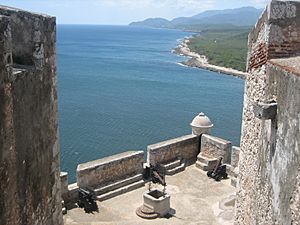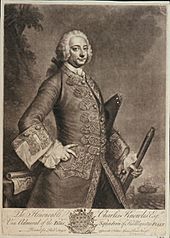Battle of Santiago de Cuba (1748) facts for kids
Quick facts for kids 2nd Battle of Santiago de Cuba |
|||||||
|---|---|---|---|---|---|---|---|
| Part of the War of Jenkins' Ear | |||||||
 View from Castillo del Morro to the Caribbean Sea. |
|||||||
|
|||||||
| Belligerents | |||||||
| Commanders and leaders | |||||||
| Strength | |||||||
2 frigates 2 sloops 1 tender |
500 regulars |
||||||
| Casualties and losses | |||||||
~200 wounded 2 ships of line disabled |
|||||||
The 2nd Battle of Santiago de Cuba happened on April 9, 1748. It was a battle where the British Royal Navy, led by Rear-Admiral Charles Knowles, tried to get into the port of Santiago de Cuba. Their goal was to disrupt Spanish trade and stop privateers. Privateers were like legal pirates who attacked enemy ships. Santiago was a major base for these Spanish privateers in the Caribbean.
During the battle, two British warships were badly damaged by the cannons of Morro Castle. They had to be pulled away to safety. The other British ships left soon after, making it a Spanish victory.
Why the Battle Happened
Sir Charles Knowles became a high-ranking admiral in 1747. He was put in charge of the British naval base in Jamaica. In 1748, he planned an attack to help Britain recover from earlier losses in the war. He wanted to hit Spanish trade and protect British ships.
On February 17, he left Port Royal with his flagship, HMS Cornwall, and seven other warships. He also had two smaller ships and a supply ship. He had about 240 Jamaican troops with him. Knowles first planned to attack Santiago de Cuba. However, strong winds made him change his mind. He decided to attack Fort Saint Louis de Sud instead.
He arrived at Fort Saint Louis de Sud on March 8, 1748. After a heavy bombing, the fort surrendered. Attacks on other towns had to be put off because he didn't have enough troops. So, Knowles decided to go ahead with the original plan to attack Santiago.
The Battle of Santiago
On the afternoon of March 28, the British fleet reached the Cuban coast. They had been joined by another warship, HMS Lenox, and three smaller ships. Captain Dent, on the ship Plymouth, scouted the entrance to Santiago's harbor. He reported that it didn't look too difficult to enter.
However, light winds kept Knowles from attacking right away. This gave the Spanish time to prepare. The governor, General Arcos Moreno, quickly ordered a large ship to be moved into the harbor entrance. A strong rope was stretched from shore to shore, partly blocking the way. The British knew there might be obstacles. They even had a Spanish pilot on board to help guide their ships. Captain Dent was told to force the pilot to help, even if it meant threatening him.
The ship Canterbury was positioned to fire on the Spanish forts. It used a large mortar (a type of cannon) that had been captured at Fort Louis. When the sea breeze picked up, the order to attack was given. The Canterbury started firing as soon as it was close enough.
The Plymouth, leading the attack, found a strong chain blocking the harbor. Captain Dent sent smaller boats to try and clear the obstacle. But his ship came under heavy fire from the Spanish forts. The Plymouth was quickly disabled. It lost its rudder (for steering), its mainmast (the main pole for sails), and its bowsprit (a pole at the front).
The Cornwall also took heavy damage. Both ships had to be pulled away to the open sea. About 100 British sailors were killed, and more than 200 were wounded. The next day, after discussing how to remove the obstacle, Knowles decided to lead his fleet back to Jamaica.
What Happened Next
After his ships were repaired, Knowles went on another mission. He hoped to capture the Spanish treasure fleet near Cuba. On September 30, he met another British ship, HMS Lenox. Its captain, Charles Holmes, reported seeing a Spanish fleet a few days earlier.
The Spanish fleet was spotted the next morning. But confusion among the British ships and problems with their positions meant they didn't attack in an organized way. This battle, known as the Battle of Havana, ended with one Spanish ship captured and another badly damaged. It was not the big British victory they had hoped for.
Knowles was later accused of managing the battle poorly. He faced a court martial in December 1749. He was officially criticized for his bad tactics. Several other captains were also reprimanded. There was a lot of bad feeling between Knowles and his officers. Some even challenged each other to duels. In one case, Knowles and Captain Holmes exchanged shots. In another, two of his captains dueled, and one was fatally wounded. Eventually, King George II had to step in and forbid any more duels over the matter.
Images for kids




